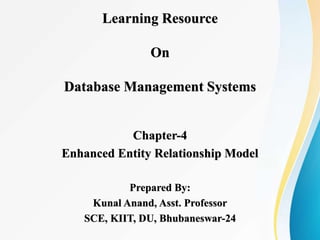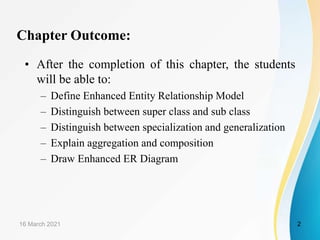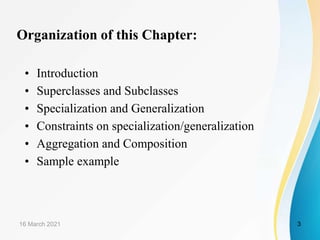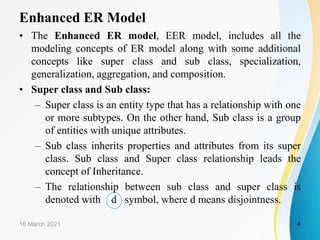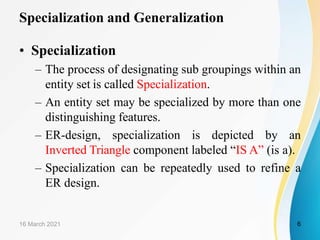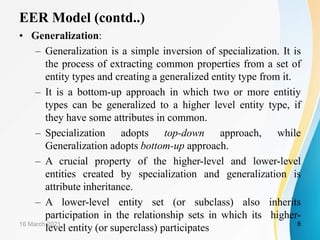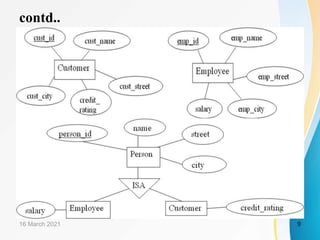Chapter-4 Enhanced ER Model
- 1. Learning Resource On Database Management Systems Chapter-4 Enhanced Entity Relationship Model Prepared By: Kunal Anand, Asst. Professor SCE, KIIT, DU, Bhubaneswar-24
- 2. Chapter Outcome: âą After the completion of this chapter, the students will be able to: â Define Enhanced Entity Relationship Model â Distinguish between super class and sub class â Distinguish between specialization and generalization â Explain aggregation and composition â Draw Enhanced ER Diagram 16 March 2021 2
- 3. Organization of this Chapter: âą Introduction âą Superclasses and Subclasses âą Specialization and Generalization âą Constraints on specialization/generalization âą Aggregation and Composition âą Sample example 16 March 2021 3
- 4. Enhanced ER Model âą The Enhanced ER model, EER model, includes all the modeling concepts of ER model along with some additional concepts like super class and sub class, specialization, generalization, aggregation, and composition. âą Super class and Sub class: â Super class is an entity type that has a relationship with one or more subtypes. On the other hand, Sub class is a group of entities with unique attributes. â Sub class inherits properties and attributes from its super class. Sub class and Super class relationship leads the concept of Inheritance. â The relationship between sub class and super class is denoted with d symbol, where d means disjointness. 16 March 2021 4
- 6. Specialization and Generalization âą Specialization â The process of designating sub groupings within an entity set is called Specialization. â An entity set may be specialized by more than one distinguishing features. â ER-design, specialization is depicted by an Inverted Triangle component labeled âIS Aâ (is a). â Specialization can be repeatedly used to refine a ER design. 16 March 2021 6
- 8. EER Model (contd..) âą Generalization: â Generalization is a simple inversion of specialization. It is the process of extracting common properties from a set of entity types and creating a generalized entity type from it. â It is a bottom-up approach in which two or more entitiy types can be generalized to a higher level entity type, if they have some attributes in common. â Specialization adopts top-down approach, while Generalization adopts bottom-up approach. â A crucial property of the higher-level and lower-level entities created by specialization and generalization is attribute inheritance. â A lower-level entity set (or subclass) also inherits participation in the relationship sets in which its higher- level entity (or superclass) participates 16 March 2021 8
- 10. Constraints on Generalization/Specialization âą Membership Constraint â Condition defined âą Membership of a specialization/generalization relationship can be defined as a condition in the requirements e.g. tanker is a ship where cargo = oil. â User-defined âą User-defined lower-level entity sets are not constrained by a membership condition; rather, the database user assigns entities to a given entity set. âą Disjoint constraints â Disjoint: âą The disjoint constraint only applies when a superclass has more than one subclass. If the subclasses are disjoint, then an entity occurrence can be a member of only one of the subclasses.e.g. postgrads or undergrads; one cannot be both. âą To represent a disjoint superclass/subclass relationship, Or is used. 16 March 2021 10
- 11. contd.. âą Overlapping: This applies when an entity occurrence may be a member of more than one subclass, e.g. student and staff; some people are both. And is used to represent the overlapping specialization/generalization relationship in the ER diagram. 16 March 2021 11
- 12. contd.. âą Completeness constraints â Total: Each superclass (higher-level entity) must belong to subclasses (lower-level entity sets), e.g. a student must be postgrad or undergrad. To represent completeness in the specialization/generalization relationship, the keyword Mandatory is used. 16 March 2021 12
- 13. contd.. âą Partial: Some superclasses may not belong to subclasses (lower-level entity sets), e.g. some people at UCT are neither student nor staff. The keyword Optional is used to represent a partial specialization/generalization relationship. 16 March 2021 13
- 14. Aggregation and Composition âą Aggregation: â Aggregation represents a has-a relationship between entity types, where one represents the whole and the other the part. â An example of aggregation is the Car and Engine entities. A car is made up of an engine. The car is the whole and the engine is the part. â Aggregation does not represent strong ownership. This means, a part can exist on its own without the whole. There is no stronger ownership between a car and the engine. An engine of a car can be moved to another car. â A line with a diamond at the end is used to represent aggregation.The whole must be put at the end of the diamond. 16 March 2021 14
- 15. contd.. âą Composition â Composition is a form of aggregation that represents an association between entities, where there is a strong ownership between the whole and the part. â For example,: a tree and a branch have a composition relationship. A branch is 'part' of a 'whole' tree - we cannot cut the branch and add it to another tree. â A line with a filled diamond at the end is used to represent composition where the diamond side is towards the part side. 16 March 2021 15
- 16. An Example 16 March 2021 16

